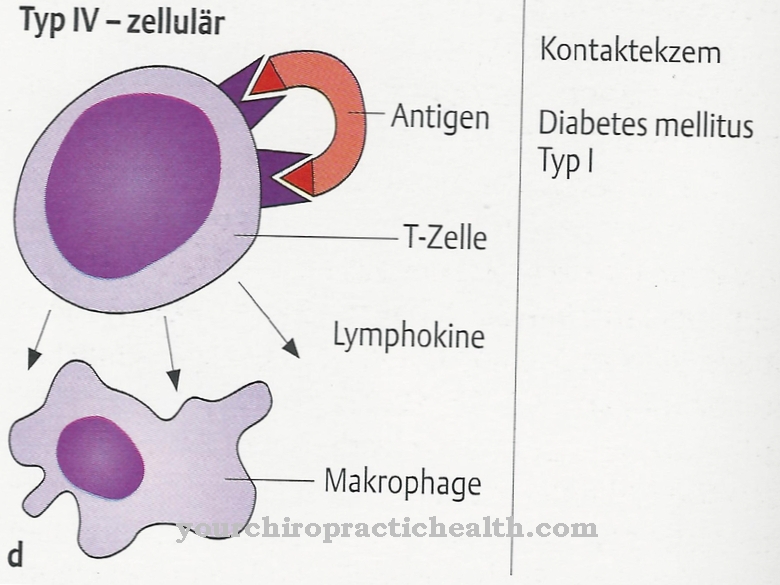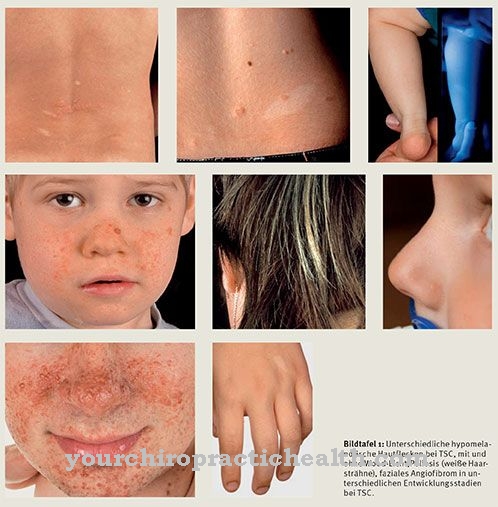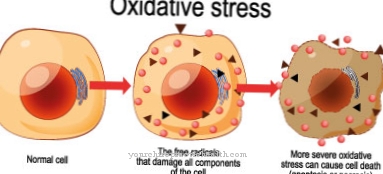Under a Osteophyte bone cultivation is understood. This new bone formation is mostly caused by joint diseases caused by wear.
What is an osteophyte?

© logo3in1 - stock.adobe.com
At a Osteophyte it is a bony outgrowth covered by smooth fiber cartilage. In most cases, it forms with degenerative bone changes on the edge of articular surfaces. The purpose of this new bone building is the attempt by the body to relieve the joint surfaces. He distributes the pressure over a larger area.
While the osteophyte structure initially appears spongy, it becomes more firm as it progresses. Osteophytes are also called Bone spur designated. The bone attachment is either sharp-edged or rounded. The osteophyte itself does not cause any painful discomfort. However, pain can result from the application of pressure to adjacent tissue, ligaments, tendons, bones or nerves.
Most patients do not notice the bone spur for years. People over 60 years of age are particularly affected by osteophytes. The risk of bone spurs increases with age. Women over the age of 50 are more likely to have osteophytes on the ankle than men.
causes
The most common cause of the development of osteophytes are joint changes that result in a remodeling of the joints. These primarily include osteoarthritis or pathological changes. Sometimes the bone spurs also serve as an adaptation to stabilize a joint.
The relationship to older age results from the fact that degenerative changes in the joints occur more frequently in this age group. Mechanical stimuli due to cartilage damage have a stimulating effect on a bone spur. Osteophyte formation in the knee can also be promoted by a cruciate ligament tear.
In addition, there is a connection between osteophyte development and local inflammation such as arthritis or tendinitis. In addition, there are bone spurs that are already innate. Cartilage damage in the joints is caused by excessive mechanical stress. Over time, the affected area becomes rougher and wears out, which in turn has a negative effect on joint movements.
In addition, the release of certain enzymes, which have the property of breaking down the cartilage more quickly, is accelerated. This process initiates the development of osteophytes. Exposure to mediators and growth factors is also of great importance for the development of osteophytes.
The transforming growth factor beta (TGF-beta) plays a major role in the formation and development of bone spurs. The osteophytes contain chondrocytes, fibroblasts, osteoblasts, prechondrocytes and hypertrophic chondrocytes. Type II collagen is the most well-known component of bone spurs.
Symptoms, ailments & signs
It is not uncommon for the osteophytes to cause no complaints for years. However, if a bone spur is in a critical part of the body, there is a risk of unpleasant discomfort. These areas include the knee, where tendons or bones are often affected by an osteophyte, and the shoulder.
If the bone spur exerts pressure on the rotator cuff tendons, which are responsible for controlling shoulder movements, signs of wear and swelling of the muscle-tendon cap appear. An osteophyte in the spine can make itself felt as pain when it presses on the spinal cord nerves.
Likewise, numbness or symptoms of failure are possible in the areas of the body that are supplied. A bone spur can be seen on the fingers as a hard swelling on the skin, which occasionally causes pain. If there is an osteophyte in the throat, there is a risk of swallowing difficulties or breathing problems.
A reduced blood supply to the brain is also conceivable if the bone spur exerts pressure on important blood vessels. In addition, there is often tingling and weakness in the arms.
Diagnosis & course of disease
Diagnosing osteophytes is not always easy. The pain caused by the bone spur is often unspecific and occurs in its immediate area. Therefore, the diagnosis usually only comes about by chance.
In some cases, palpation during the physical examination reveals pain and discomfort from the osteophyte. However, it is often not possible to trace deeper-lying bone spurs from the outside. For this reason, an X-ray examination is usually carried out, with the help of which the position and extent of the bone spur can be determined. However, if the bone formation is very small, X-rays may not always be sufficient.
If muscles or nerves are involved, computed tomography (CT) or magnetic resonance imaging (MRI) is often performed. In most cases, osteophytes will progress positively when treated appropriately. However, some patients suffer from considerable impairment when the bone spur presses against adjacent nerves.
Complications
Due to the osteophyte, patients suffer from various bone ailments and also from joint problems. In most cases, the symptoms appear very suddenly, so that the disease does not show any particular symptoms at first. For this reason, early treatment is usually not possible. Especially in the knees, pain and restricted mobility can occur, which have a very negative effect on the patient's everyday life.
The shoulder can also hurt. If the osteophyte is not treated, there are usually symptoms of the spine and furthermore numbness and other disorders of sensitivity. Swallowing and breathing difficulties also occur, so that the ingestion of food and liquids is no longer easily possible for the patient.
The resilience of the person affected also drops considerably due to the osteophyte, so that there are considerable restrictions in everyday life. This condition is usually treated with the help of medication. Various therapies and a healthy lifestyle can also have a positive effect on the disease.
When should you go to the doctor?
Osteophytes can develop for years without initially experiencing any unusual symptoms. If the typical swellings and ossification in the area of the joints are noticed, a doctor must be consulted. Nerve pain or failure symptoms also indicate an osteophyte or another disease that needs to be clarified. Vocal cord paralysis and poor posture are reasons to see a doctor immediately, as they indicate advanced disease. Pain therapy is unproblematic and does not have to be monitored by a doctor.
On the other hand, regular checks are necessary after an operation to ensure smooth healing. Patients should consult a physiotherapist after surgery to alleviate any musculoskeletal disorders. The degenerative bone changes themselves are surgically removed or treated by an orthopedic surgeon. The general practitioner can usually take care of the routine examinations during treatment and aftercare. However, an orthopedic surgeon must always be involved in the treatment, as osteophytes and osteochondromas mainly affect the bones and must be treated by a suitable specialist.
Treatment & Therapy
If an osteophyte does not cause any symptoms, no special treatment is usually necessary. Ultimately, the therapy depends on how severe the symptoms are. To combat the pain, the patient is usually given nonsteroidal anti-inflammatory drugs (NSAIDs). Their use can reduce inflammation and pain in the affected area.
Another proven form of treatment is physical therapy. The muscles around the bone spurs are strengthened through special exercises and are given more freedom of movement. In the case of severe joint impairments, the doctor can also give cortisone, which he uses to counteract the pain.
If the patient suffers from osteophytes on the leg, the use of orthoses is considered useful for pain relief. Operations, on the other hand, are rarely carried out if conservative therapy is unsuccessful.
You can find your medication here
➔ Medicines for painOutlook & forecast
The prognosis for osteophytes is poor. The cause of the affected person is a chronic disease that has a progressive course of the disease. For this reason there is no recovery given the current medical and scientific status. Rather, a steady increase in complaints over the life span is to be expected.
Medical care focuses on delaying the progression of the disease. Medicinal therapeutic approaches are intended to prevent the health irregularities from leading to severe impairment of quality of life or everyday life within a short period of time. Rather, it is about saving time so that the patient can fulfill his daily obligations independently for as long as possible.
Professional as well as sporting obligations are often restricted because the physical performance can no longer be performed as usual. Because of the underlying disease, the risk of developing secondary disorders is increased. The emotional burden increases, so that mental disorders can often be observed.
Without treatment, the various symptoms lead to an immense loss of general quality of life. In addition to irregular movements, pain and a loss of strength, inflammation can occur. In many cases, a rapid increase in complaints can also be expected. As a result, the person affected can no longer cope with everyday life without help.
prevention
In order to prevent osteophytes, it is necessary to counteract the triggering causes such as inflammation. Regular exercise is also considered helpful.
Aftercare
As a rule, follow-up measures for an osteophyte are relatively limited or, in some cases, are not even available to those affected. For this reason, a doctor should be consulted at the first symptoms and signs so that further complications can be prevented. Self-healing cannot occur, so ideally a doctor should be consulted at the first signs and symptoms of the disease.
Most people affected depend on various medications that can relieve their symptoms. The person concerned should always pay attention to the correct dosage and continue to take the medication regularly so that there are no other compilations or complaints.
Most of those affected also need the help and support of their own family and friends during treatment. This can also prevent or alleviate depression and other psychological complaints. Under certain circumstances, the disease can also lead to a reduced life expectancy for those affected.
You can do that yourself
Osteophytes usually require medical treatment. After an operation, the patient must first take it easy. In particular, the affected bone must not be exposed to any further stress. For this reason, the doctor will prescribe physiotherapy, which is best supported by the patient through moderate exercise, but also through massages, exercises from yoga and Pilates and relaxation exercises.
Possible causes must be identified and remedied so that an osteophyte does not recur. Often the disease is based on another condition, for example osteoarthritis or sclerosis, which must be treated first. If no cause can be determined, general measures are indicated. The patient should exercise the joints regularly, but without overloading them.
A healthy diet and the avoidance of stress serve as additional self-help measures for an osteophyte. If the osteophytes appear in connection with the use of medication, it is necessary to switch to another preparation. In the first time after changing the medication, the sick person should consult the doctor closely so that appropriate adjustments can be made in the event of side effects and interactions.




























.jpg)